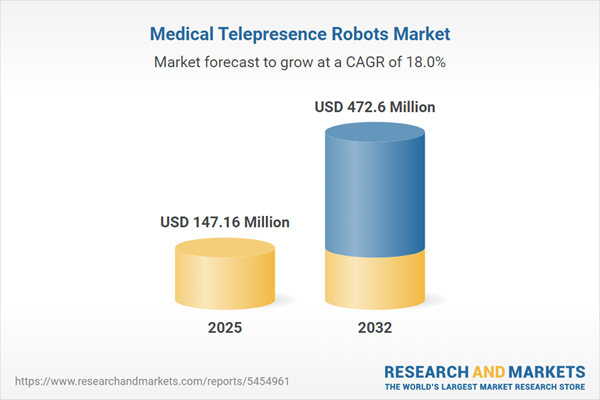Speak directly to the analyst to clarify any post sales queries you may have.
The medical telepresence robots market is entering a pivotal phase, with dynamic changes in healthcare delivery models fueling enterprise adoption worldwide. Senior decision-makers are now looking to telepresence robotics as a strategic lever for operational agility, enhanced care access, and workflow transformation across a rapidly evolving healthcare landscape.
Market Snapshot: Medical Telepresence Robots Market Size and Growth
The Medical Telepresence Robots Market grew from USD 125.66 million in 2024 to USD 147.16 million in 2025. It is projected to continue expanding at a compound annual growth rate (CAGR) of 18.00%, reaching USD 472.60 million by 2032. These figures underscore robust market momentum and expanding opportunities for solution providers and healthcare organizations alike.
Scope & Segmentation of the Medical Telepresence Robots Market
- Robot Type: Mobile telepresence robots, stationary telepresence robots
- Component: Hardware (camera system, control system, microphone, screen, speaker); Services (installation & maintenance, training & support); Software
- Application: Patient interaction, remote surgery assistance (general surgery, neurosurgery, orthopedic surgery), teleconsultation & telemedicine, telemonitoring (chronic disease management, postoperative care)
- End User: Ambulatory surgical centers, clinics, home healthcare, hospitals
- Sales Channel: Offline, online
- Regional Coverage: Americas (United States, Canada, Mexico, Brazil, Argentina, Chile, Colombia, Peru); Europe, Middle East & Africa (United Kingdom, Germany, France, Russia, Italy, Spain, Netherlands, Sweden, Poland, Switzerland, United Arab Emirates, Saudi Arabia, Qatar, Turkey, Israel, South Africa, Nigeria, Egypt, Kenya); Asia-Pacific (China, India, Japan, Australia, South Korea, Indonesia, Thailand, Malaysia, Singapore, Taiwan)
- Key Companies: ADIBOT, Ava Robotics, Inc., Awabot SAS, AXYN Robotics, Brainlab AG, Cisco Systems, Inc., Diligent Robotics, Inc., GOBE ROBOTS by Blue Ocean Robotics ApS, Intuitive Surgical, Inc., Kubi by Xandex, Inc., Medtronic plc, OhmniLabs, Inc., Teladoc Health, Inc., Telepresence Robotics Corporation, Vecna Technologies, Inc., Zimmer Biomet Holdings, Inc.
Key Takeaways for Senior Decision-Makers
- Medical telepresence robot solutions are increasingly central to remote healthcare delivery, supporting patient interaction, teleconsultation, and surgical assistance across diverse care settings.
- Healthcare organizations are integrating AI-enhanced telepresence platforms, advanced connectivity, and modular architectures to meet evolving clinician and patient expectations.
- Regulatory frameworks for device safety, privacy, and telehealth reimbursement are streamlining adoption while reducing implementation risk for providers and manufacturers.
- Partnerships between robotics firms, medical device manufacturers, and healthcare institutions are advancing innovation pipelines and validating new clinical applications.
- Procurement and deployment strategies continue to evolve, with digital marketplaces complementing traditional distribution channels and influencing support models.
- Emerging regions are accelerating investments in digital infrastructure, creating new opportunities for suppliers positioned to address local needs and compliance.
Tariff Impact: United States Trade Policy and Supply Chain Strategy
Recent US tariff changes are prompting manufacturers and stakeholders to reassess sourcing and supplier relationships within the medical telepresence robots sector. Increased duties on core electronic components—such as camera modules and control systems—are driving a shift toward diversified production strategies, including nearshoring assembly and fostering domestic partnerships. Design teams are also prioritizing modular architectures for greater resilience. These adaptations aim to maintain delivery timelines, secure cost structures, and encourage long-term regional growth despite tariff pressures.
Methodology & Data Sources
This report is based on a hybrid research approach. Qualitative insights are drawn from interviews with healthcare leaders, robotics engineers, and clinical users across global regions. Quantitative data comes from regulatory filings, patent databases, and audited public financials. Secondary research includes analysis of leading industry white papers, policy documents, and technology roadmaps. Multiple data sources were validated through triangulation to ensure accuracy and objectivity.
Why This Report Matters for the Medical Telepresence Robots Market
- Enables strategic assessment of market segments, technology adoption, and region-specific drivers.
- Provides actionable guidance for optimizing supply chain, procurement, and innovation partnerships in a changing trade landscape.
- Equips decision-makers with relevant competitive intelligence across both established and emerging players.
Conclusion
With mounting demand for accessible, scalable care delivery, medical telepresence robots are primed to play a critical role in the digital healthcare future. Organizations that prioritize modularity, forge effective ecosystem collaborations, and invest in data-driven operations will be positioned to lead in this rapidly expanding market.
Additional Product Information:
- Purchase of this report includes 1 year online access with quarterly updates.
- This report can be updated on request. Please contact our Customer Experience team using the Ask a Question widget on our website.
Table of Contents
3. Executive Summary
4. Market Overview
7. Cumulative Impact of Artificial Intelligence 2025
Companies Mentioned
The companies profiled in this Medical Telepresence Robots market report include:- ADIBOT
- Ava Robotics, Inc.
- Awabot SAS
- AXYN Robotics
- Brainlab AG
- Cisco Systems, Inc.
- Diligent Robotics, Inc.
- GOBE ROBOTS by Blue Ocean Robotics ApS
- Intuitive Surgical, Inc.
- Kubi by Xandex, Inc.
- Medtronic plc
- OhmniLabs, Inc.
- Teladoc Health, Inc.
- Telepresence Robotics Corporation
- Vecna Technologies, Inc.
- Zimmer Biomet Holdings, Inc.
Table Information
| Report Attribute | Details |
|---|---|
| No. of Pages | 191 |
| Published | November 2025 |
| Forecast Period | 2025 - 2032 |
| Estimated Market Value ( USD | $ 147.16 Million |
| Forecasted Market Value ( USD | $ 472.6 Million |
| Compound Annual Growth Rate | 18.0% |
| Regions Covered | Global |
| No. of Companies Mentioned | 17 |









